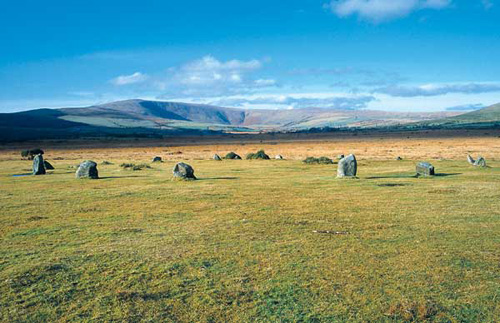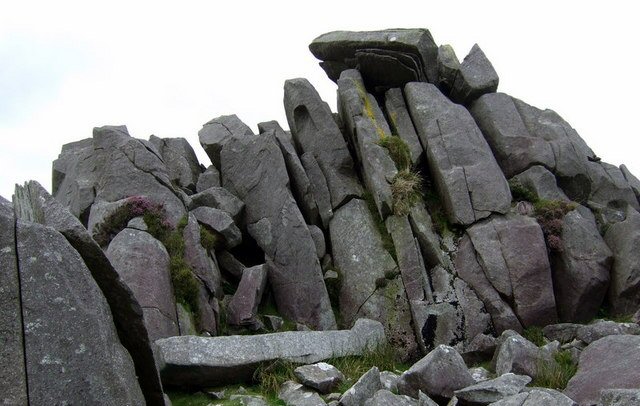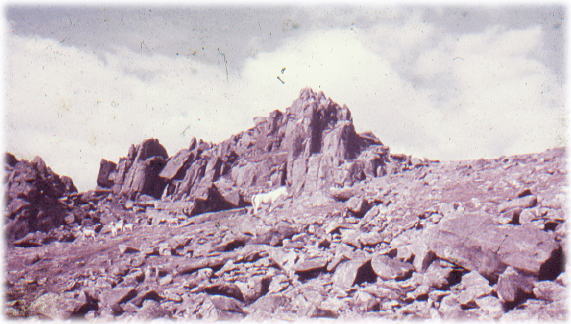|
Location: Nr. Mynachlog Ddu,
Pembrokeshire, Wales. |
Grid Reference:
51� 55' 53" N, 4� 42' 47" W. |

 Gors Fawr:
(Stone Circle, Avenue).
Gors Fawr:
(Stone Circle, Avenue).
An
important relic of the prehistoric Welsh landscape.
The sitting of this circle is
particularly interesting as it lies just to the south of the Preseli
Mountains - these hills being the place where the Stonehenge bluestones
originated. Despite this close proximity to the source of these obviously
sacred stones, only half were used in the making of this circle, the rest are
composed of local glacial erratic boulders.
(Map with location)
| Gors Fawr:
('Cylch y Trallwyn',
'Great Marsh') |
'This near-perfect circle of sixteen stones measuring about
22 metres in diameter. Eight of the stones are of spotted dolerite, the
famous �bluestone� sourced as being from the Carn Meini outcrops to the
north (Burl mentions only one). Recent geophysical survey by the SPACES
project, searching for any buried structures which might lie hidden beneath
the circle, revealed nothing. The conclusion is that this monument probably
looks much the same today as it did to its late Neolithic or Bronze Age
builders. Nearby is a pair of standing stones (NPRN 304281) which appears to
frame the distant Carn Menyn outcrop when viewed from the south-west. In his
1963 Shell Guide, Vyvyan Rees was unimpressed; �Gors Fawr, the only
recognisable stone circle left in the county, is very small�. It is, in
fact, a remarkable survivor and one of the best of its kind to be seen in
Wales'. (1)
(From Driver, T. 2006. Pembrokeshire: Historic Landscapes from the Air.
RCAHMW, p121)
Although the stones that form the circle are
comparatively small (1 - 1.5m tall), they are graded in height as noted by
Burl (A. Burl, The Stone
Circles of the British Isles, Yale U.P., 1976) and other archaeologists.
The tallest surviving stones form the south-eastern quadrant of the circle,
with the lowest to the west-southwest.
The two large outlying pillar stones 134 m to the north-northeast of the stone
circle are positioned 13.7 m apart. They could be viewed as an alignment or as a
�portal� with the stones acting like gateposts framing a view between them. As
an alignment, the two standing stones form a southwest-northeast orientation,
and this points in the north-easterly direction to the position of the midsummer
sunrise alignment over the nearby hill of Foel Drych (A.Thom, Megalithic
Sites in Britain, Oxford U.P., 1967), now unfortunately obscured by local
tree cover.
There are indications that there was once an avenue leading to the two
outliers, which are found to the north-north-east.
One of the outliers ( 'The
dreaming stone'), is said to have
strong magnetic qualities. Paul Devereux speculated:
'The magnetic stone has a curious shape
that allows it to form a seat; using this to sit on the stone,
one's head leans back on precisely that part of the outlier
which most affects a compass. It is not beyond the bounds of
possibility that if one is in a certain mental state, engendered
by fasting, dancing or hallucinogens, the placing of the
head in the stone's magnetic field may trigger or enhance
visionary or spiritual experiences, the hippocampus being subtly
massaged by the magnetism'.
(2)
|
Bluestone: 'Blue Spotted Dolerite'
In 1923
petrological examination confirmed the scattered outcrops of Carn Meini
on the south-west of Mynydd Preseli as being the source of the
distinctive blue-grey spotted dolerite with large white spots used in
some of the earliest phases.
If you take a line of sight from the
southernmost stone in the Gors Fawr circle and line this up mid way between the
standing stones it points in the direction of a rocky outcrop 'Carn Menyn'
on the Preseli Hills where the bluestones of stone henge are thought to have
been derived.
This parcel of land is/was the recipient of streams
coming off Mynydd Preseli, on which Carn Menyn is situated, so there is a
physical as well as visual link between the two areas. There may also have
been a ceremonial, symbolic link, and the route of the bluestones off
Preseli at the beginning of their journey to Stonehenge may have passed by
Gors Fawr, according to the Pilot Study�s consultant, Professor Timothy
Darvill.

The dolerite outcrops appear as if the stones are stacked
and ready for use.
It has been suggested that certain stones from places that
were 'venerated' were circulated over considerable distances in the
Neolithic era of prehistory. These �pieces of places� are considered as
relics 'charged with the sanctity, the mana, of their homeland, much
as the bones of saints that were circulated and venerated in Medieval times
were thought to possess magical and healing qualities'. So what besides their
colour made these bluestones so special?
'There is an intriguing aspect
to the Preseli bluestones � a relatively high proportion of them
(perhaps as much as ten percent) have the usually rare property of
being �musical�. That is, they can ring like a bell or gong, or
resound like a drum, when struck with a small hammer-stone,
instead of the dull clunking sound rock-on-rock usually makes.
That this property has been noted locally down the generations is
shown by the �Maenclochog� (�Ringing stones�) village place-name
in the Preseli area'. (2)
(More about specific selectivity of stone)
|
Alignments:
A
significant alignment is formed by the stone circle, the remains of an
avenue, the outliers, Carn Menyn and once a year, the Mid-summer sunrise.
The specific design and placement of the circle therefore manages to unite
us through the stones to both the landscape and the solar cycle.
Beddarthur, is intervisible with Gors Fawr and both monuments are
intervisible with Carn Menyn.
|
Carn Menyn: The
Primal Mound.
It can be seen that the Carn Menyn and neighbouring cluster of rocky outcrops on Preseli form the central
skyline as viewed from the circle. This phenomenon of a possible 'primal
mound'
visible on the extreme horizon to the north of a stone circle�s position
recurs time and again throughout the British Isles so the monument was
probably not randomly located.
The theme of the
'Primal mound' (with an associated prominent stone-circle) is
repeated at several of the most significant Neolithic sites in
Europe, in which the monuments form part of larger 'ceremonial
landscapes', which appear to have been selected and built into in
such a way so as to 'unite' people, stones, landscape features and
even the heavens. Classic examples can be seen at Avebury/Silbury
and Maes Howe/Stennes (Brodgar), although there are several other
good examples.
(More on this subject) |

And old photo of Carn Menyn (With
complimentary white horses)
(Other Welsh Sites)
|



